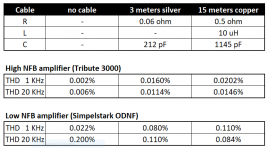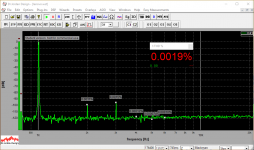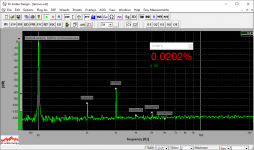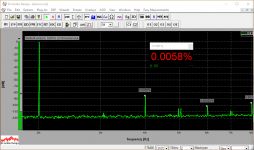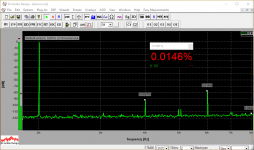Speaker cables don't introduce harmonic distortion,
however, they do influence the overall harmonic distortion of the system (amplifier + cable + speaker) indirectly.
Here are some practical proofs, including the right way to measure:
Correct connection of the audio analyzer
Low-frequency measurements with the real speaker
The way a cable influences the overall performance of the system
Cool thoughts on DF by GoatGuy + futher discussion
~~~~~~~~~~~~~~~~~~~~~~~~~~~~
That's how it all started:
Hi All,
A few weeks ago XRK971 drew my attention to the fact that different quality speaker cables result in harmonic distortion increase - particularly H3 goes up.
As I'm taken by low-feedback designs these days, I decided to run a quick live test with my prototypes. I used two cables I have in hand, both are rather high-quality:
1) stranded copper cable with silver coating (3 meters long);
2) stranded copper cable with no coating (15 meters long).
The results are rather interesting.
1) Summary of measurements (R/L/C values are shown for each cable);
2) THD 1 KHz with no cable;
3) THD 1 KHz with 15 meters cable;
2) THD 20 KHz with no cable;
3) THD 20 KHz with 15 meters cable.
Those spectrums are shown for the high-NFB amplifier (Tribute 3000).
I'm going to continue experiments in this area, especially exploring the low-feedback configurations.
Cheers,
Valery
however, they do influence the overall harmonic distortion of the system (amplifier + cable + speaker) indirectly.
Here are some practical proofs, including the right way to measure:
Correct connection of the audio analyzer
Low-frequency measurements with the real speaker
The way a cable influences the overall performance of the system
Cool thoughts on DF by GoatGuy + futher discussion
~~~~~~~~~~~~~~~~~~~~~~~~~~~~
That's how it all started:
Hi All,
A few weeks ago XRK971 drew my attention to the fact that different quality speaker cables result in harmonic distortion increase - particularly H3 goes up.
As I'm taken by low-feedback designs these days, I decided to run a quick live test with my prototypes. I used two cables I have in hand, both are rather high-quality:
1) stranded copper cable with silver coating (3 meters long);
2) stranded copper cable with no coating (15 meters long).
The results are rather interesting.
- Distortion increase is significantly more noticeable at 1KHz than it is at 20KHz;
- Harmonic that grows the most is H3 (H2 even goes down in some cases);
- The effect is much less noticeable with low-feedback amplifier than it is with "normal" - high-feedback - amplifier. Distortion at 20KHz even goes down with longer cable as soon as the feedback loop gain is low (18db in my case).
1) Summary of measurements (R/L/C values are shown for each cable);
2) THD 1 KHz with no cable;
3) THD 1 KHz with 15 meters cable;
2) THD 20 KHz with no cable;
3) THD 20 KHz with 15 meters cable.
Those spectrums are shown for the high-NFB amplifier (Tribute 3000).
I'm going to continue experiments in this area, especially exploring the low-feedback configurations.
Cheers,
Valery
Attachments
Last edited:
That's a large increase in third harmonic right there with the cables attached.
Interestingly, when I was building, and troubleshooting class A/AB amplifiers etc I did do measurements with some speakers attached and didn't actually find a tremendous difference in harmonic spectra. I am going to contradict myself as much as saying there was an obvious difference, the distortion rose, but not by a tremendous amount.
I wasn't testing at particularly high power levels though and distortion was down at 0.0005% for the 1kHz, short cables, dummy load, test. Your amplifier is quite different. I don't remember the distortion rising by anywhere near as much as your results are showing but I could be remembering incorrectly.
Interestingly, when I was building, and troubleshooting class A/AB amplifiers etc I did do measurements with some speakers attached and didn't actually find a tremendous difference in harmonic spectra. I am going to contradict myself as much as saying there was an obvious difference, the distortion rose, but not by a tremendous amount.
I wasn't testing at particularly high power levels though and distortion was down at 0.0005% for the 1kHz, short cables, dummy load, test. Your amplifier is quite different. I don't remember the distortion rising by anywhere near as much as your results are showing but I could be remembering incorrectly.
I'm going to continue experiments in this area, especially exploring the low-feedback configurations.
I would recommend testing with a zobel attached at the far end of
the cable, something like .047uf in series with 5 or 10 ohms.
Hi, Valery, it’s better to add something low-freq, say 30-100 Hz.
The main issue with the cables is its intrinsic resistance.
Feedback to the amp’s core is taken from the amp’s output terminals, so the wire resistanse with load forms simple divider.
Additionally long or thin wire formally acts as amp’s output resistanse, which in case drops damping factor.
Taking feedback from the load could be a good way, but you will need to dissolve and compensate/exclude common mode error and noise.
The best way is to use Calvin 4-wire load connection and fully-differential amplifier. In this case you can simply put common mode chokes at both output and feedback terminals.
The main issue with the cables is its intrinsic resistance.
Feedback to the amp’s core is taken from the amp’s output terminals, so the wire resistanse with load forms simple divider.
Additionally long or thin wire formally acts as amp’s output resistanse, which in case drops damping factor.
Taking feedback from the load could be a good way, but you will need to dissolve and compensate/exclude common mode error and noise.
The best way is to use Calvin 4-wire load connection and fully-differential amplifier. In this case you can simply put common mode chokes at both output and feedback terminals.
I would recommend testing with a zobel attached at the far end of
the cable, something like .047uf in series with 5 or 10 ohms.
Thank you Nelson, I will try adding zobel at the load end of the cable.
Cheers,
Valery
Hi, Valery, it’s better to add something low-freq, say 30-100 Hz.
The main issue with the cables is its intrinsic resistance.
Feedback to the amp’s core is taken from the amp’s output terminals, so the wire resistanse with load forms simple divider.
Additionally long or thin wire formally acts as amp’s output resistanse, which in case drops damping factor.
Taking feedback from the load could be a good way, but you will need to dissolve and compensate/exclude common mode error and noise.
The best way is to use Calvin 4-wire load connection and fully-differential amplifier. In this case you can simply put common mode chokes at both output and feedback terminals.
Hi Pavel, yes, in the end of the exercise I thought I will measure some low frequency spectrums as well. It would be also interesting to see what the square wave is going to look like - to see what happens to fast transients.
Very strange: I think all serious people agree that the intrinsic distortion of the cable itself is vanishingly low, well under the ppm.
This leaves the amplifiers or unknown artifacts as possible explanations.
Such a gross increase in THD caused by a relatively minor change in the load impedance would seem to indicate a pathological behavior from the amplifier(s).
Tests I have done myself show that the THD is indeed dependent on the nature of the load, inductive, capacitive or resistive, but the change is at most like 1 to 2 or 1 to 0.5, and that's for a purely reactive load whose magnitude at the test frequency equals Znom.
I would look at possible artifacts: for example the grounding: the test generator has its ground connected to the amplifier side, whilst the THD meter is connected to the far end of the cable.
If both equipments are earthed, this will cause a ground loop, with unpredictable results.
That is only one example, many other possible pitfalls exist
This leaves the amplifiers or unknown artifacts as possible explanations.
Such a gross increase in THD caused by a relatively minor change in the load impedance would seem to indicate a pathological behavior from the amplifier(s).
Tests I have done myself show that the THD is indeed dependent on the nature of the load, inductive, capacitive or resistive, but the change is at most like 1 to 2 or 1 to 0.5, and that's for a purely reactive load whose magnitude at the test frequency equals Znom.
I would look at possible artifacts: for example the grounding: the test generator has its ground connected to the amplifier side, whilst the THD meter is connected to the far end of the cable.
If both equipments are earthed, this will cause a ground loop, with unpredictable results.
That is only one example, many other possible pitfalls exist
Hi Elvee,
Load impedance change is very small. Look at it from a different perspective (from the load side of the cable) - output impedance of the amplifier is changed dramatically (I measure at the load, so the cable complex impedance adds up to the output impedance of the amplifier).
This is confirmed by my measurements with the low-feedback amplifier, having much higher output impedance, than the other one - distortion increase is much lower at 1KHz and it comes to decrease at 20KHz.
Try to measure at the load side of the cable - you'll see the difference.
Cheers,
Valery
Load impedance change is very small. Look at it from a different perspective (from the load side of the cable) - output impedance of the amplifier is changed dramatically (I measure at the load, so the cable complex impedance adds up to the output impedance of the amplifier).
This is confirmed by my measurements with the low-feedback amplifier, having much higher output impedance, than the other one - distortion increase is much lower at 1KHz and it comes to decrease at 20KHz.
Try to measure at the load side of the cable - you'll see the difference.
Cheers,
Valery
As a "bulletproof" solution, I can connect the analyzer's input in a balanced way in AC mode, leaving the input ground wire of the analyzer hanging in the air. In this case, analyzer's input will have no direct connection to the load resistor, ensuring no ground loop in place. I'll try this tomorrow.
Perhaps, but this could result in distortion only if the load or the cable is non-linear.Look at it from a different perspective (from the load side of the cable) - output impedance of the amplifier is changed dramatically (I measure at the load, so the cable complex impedance adds up to the output impedance of the amplifier).
With a real speaker, that would be the case, but since you make the measurement with a dummy load*, and the cable is normally above suspicion, the only remaining source of non-linearity has to be the amplifier itself.
If the amplifier is proved to be the culprit, one would have to formulate a hypothesis as to why such a minor disturbance in the load, acting mainly at frequencies well above the audio spectrum, has such a massive impact at low frequencies -and come up with a protocol to validate the hypothesis-
*Beware also of low-ohm wirewound resistors: they can sometimes exhibit surprising amounts of non-linearity
If I’m getting weird distortion changes with load, I find the culprit is usually oscillation.
All amplifiers tested have got no stability issues
Perhaps, but this could result in distortion only if the load or the cable is non-linear.
With a real speaker, that would be the case, but since you make the measurement with a dummy load*, and the cable is normally above suspicion, the only remaining source of non-linearity has to be the amplifier itself.
If the amplifier is proved to be the culprit, one would have to formulate a hypothesis as to why such a minor disturbance in the load, acting mainly at frequencies well above the audio spectrum, has such a massive impact at low frequencies -and come up with a protocol to validate the hypothesis-
*Beware also of low-ohm wirewound resistors: they can sometimes exhibit surprising amounts of non-linearity
Or there's something wrong with the way I measure the spectrums, as Jeff just mentioned (ground connection through the analyzer).
We'll see tomorrow.
- Status
- This old topic is closed. If you want to reopen this topic, contact a moderator using the "Report Post" button.
- Home
- Amplifiers
- Solid State
- Speaker cables don't influence harmonic distortion!
